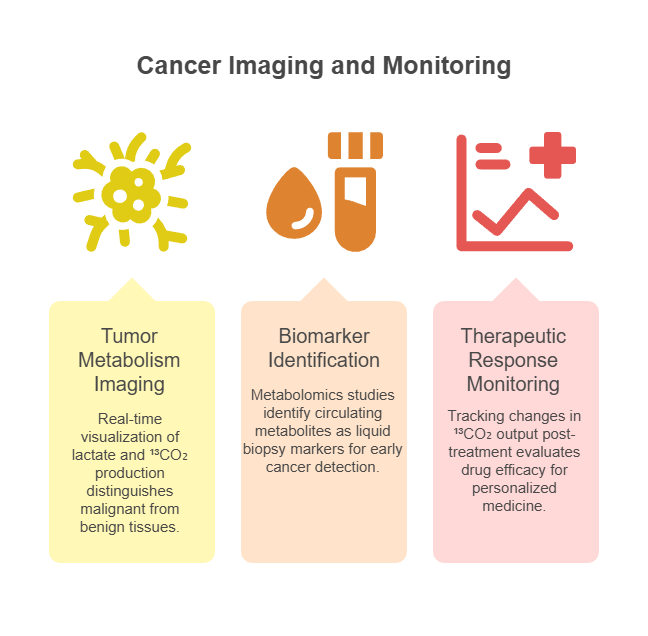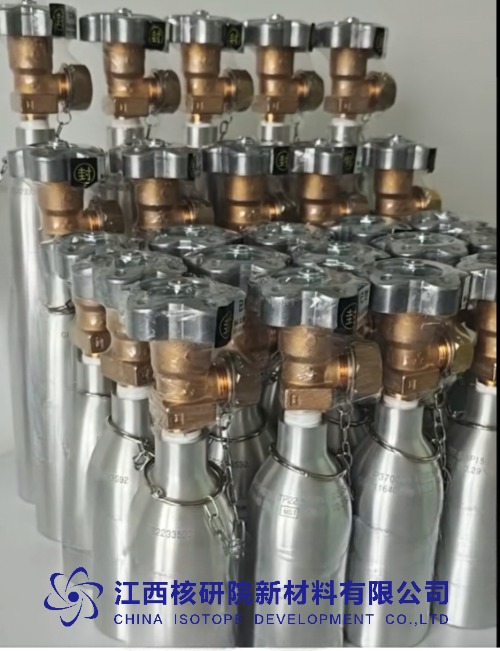¹³CO₂ Isotopic Gas: From Photosynthesis Research to Cancer Diagnosis
BY Tao, Published Aug 12, 2025
The realm of isotopic gases has revolutionized scientific inquiry, with ¹³CO₂ standing out as a versatile tracer in biological and medical fields. As a stable isotope of carbon dioxide, ¹³CO₂ enables precise tracking of carbon atoms through complex pathways, from the fundamental processes of plant life to the intricate mechanisms of human disease. This article delves into the applications of ¹³CO₂ isotopic gas in photosynthesis research and cancer diagnosis, drawing on decades of expertise in nuclear elements and isotopic studies to highlight its profound impact.
Understanding ¹³CO₂ Isotopic Gas: A Stable Tracer for Precision Science
¹³CO₂, or carbon-13 dioxide, is a non-radioactive isotopic variant of carbon dioxide where the carbon atom has an atomic mass of 13 due to an extra neutron. This subtle difference allows for detection via techniques like nuclear magnetic resonance (NMR) and isotope ratio mass spectrometry (IRMS) without disrupting natural processes. In photosynthesis research, ¹³CO₂ serves as a label to trace carbon fixation, while in cancer diagnosis, it aids in mapping aberrant metabolic pathways. Its stability and compatibility with living systems make it an ideal tool for non-invasive studies, ensuring safety and accuracy in both environmental and clinical settings.
The production of ¹³CO₂ involves enriching natural CO₂ sources, where ¹³C comprises only about 1.1% of carbon, to high purity levels. This enrichment process, often achieved through cryogenic distillation or chemical exchange, results in a gas that can be incorporated into substrates for targeted experiments. Over years of research in rare gases and isotopes, I’ve observed how ¹³CO₂’s unique properties bridge basic science and applied medicine, offering insights that unlabeled CO₂ simply cannot provide.
Applications in Photosynthesis Research
Photosynthesis, the cornerstone of life on Earth, converts CO₂ into organic compounds using sunlight. ¹³CO₂ isotopic gas has become indispensable in unraveling the intricacies of this process, allowing researchers to quantify carbon flux and identify bottlenecks in plant metabolism. Recent advances have shown how labeling plant leaves with ¹³CO₂ enhances accessibility for tracer studies, providing real-time data on metabolic fluxes during carbon assimilation.
Key applications include:
-
Carbon Flux Mapping: By introducing ¹³CO₂ into controlled environments, scientists track its incorporation into sugars and other metabolites via the Calvin-Benson cycle. This reveals how plants adapt to elevated CO₂ levels, crucial for understanding climate change impacts.
-
Gene Function Studies: Discoveries in genes that boost photosynthesis efficiency, such as those enhancing tree growth by up to 30% in fields, rely on ¹³CO₂ to measure improved carbon fixation rates.
-
Environmental Stress Responses: ¹³CO₂ helps assess how factors like UV-B radiation or drought alter photosynthetic pathways, informing crop improvement strategies for resilient agriculture.
These uses demonstrate ¹³CO₂’s role in advancing our knowledge of plant physiology, with implications for sustainable food production and bioenergy.
Role in Cancer Diagnosis
In oncology, metabolic reprogramming is a hallmark of cancer, where cells shift to aerobic glycolysis for rapid proliferation. ¹³CO₂ isotopic gas plays a critical role in diagnosing and characterizing these changes through hyperpolarized ¹³C magnetic resonance spectroscopic imaging (MRSI). By labeling substrates like pyruvate with ¹³C, clinicians can monitor the release of ¹³CO₂ as a byproduct of tumor metabolism, offering a non-invasive window into disease progression.
Prominent applications encompass:

-
Tumor Metabolism Imaging: Hyperpolarized ¹³C-pyruvate injections allow real-time visualization of lactate and ¹³CO₂ production in tumors, distinguishing malignant from benign tissues with high sensitivity.
-
Biomarker Identification: Metabolomics studies using ¹³CO₂ tracers identify circulating metabolites as liquid biopsy markers, enabling early detection of cancers like prostate or breast.
-
Therapeutic Response Monitoring: Tracking changes in ¹³CO₂ output post-treatment helps evaluate drug efficacy, guiding personalized medicine approaches.
Through these methods, ¹³CO₂ enhances diagnostic precision, reducing the need for invasive biopsies and improving patient outcomes in cancer care.
Technical Advantages of ¹³CO₂
The efficacy of ¹³CO₂ stems from its inherent advantages over other tracers, making it a preferred choice in diverse research domains.
|
Advantage |
Description |
|---|---|
|
Stability |
Non-radioactive, allowing safe, long-term studies without decay concerns. |
|
Detectability |
High sensitivity in IRMS and NMR, enabling low-dose applications. |
|
Biological Integration |
Mimics natural CO₂ behavior, ensuring minimal perturbation to systems. |
|
Versatility |
Applicable in gas form or labeled compounds for varied experimental designs. |
These features underscore why ¹³CO₂ remains a gold standard in isotopic tracing, blending safety with scientific rigor.
Product Specifications and Usage Guidelines
For practical implementation, ¹³CO₂ is available as a high-purity isotopic gas, often in mixtures tailored for specific applications. A typical research-grade product includes:
-
Product Name: ¹³CO₂ Isotopic Gas, Enriched
-
Isotopic Enrichment: ≥99 atom % ¹³C
-
Chemical Formula: ¹³CO₂
-
Molecular Weight: 45 g/mol
-
Physical State: Colorless, odorless gas at standard conditions
-
Purity: ≥99.9% (excluding isotopic composition)
-
Packaging: Supplied in high-pressure cylinders (1L to 10L) or as pre-mixed with N₂ and O₂ (e.g., 1:78:21 ratio for atmospheric simulation)
-
Storage: Keep in a cool, ventilated area below 50°C; avoid direct sunlight and incompatible materials like strong bases.
-
Shelf Life: Indefinite when stored properly, due to stability.
Performance Highlights:
-
Exceptional for isotope ratio analysis, with precise δ¹³C measurements via specialized analyzers.
-
Compatible with breath tests, inhalation studies, and substrate labeling.
-
Cost-effective for high-enrichment needs, balancing purity with experimental demands.
Usage Guidelines and Precautions:
-
Handling: Use in fume hoods or well-ventilated spaces to prevent CO₂ buildup; wear protective gloves and eye gear.
-
Administration: For photosynthesis chambers, introduce at concentrations mimicking ambient levels (e.g., 400 ppm); in medical settings, use labeled substrates under ethical guidelines.
-
Analysis: Calibrate instruments like Picarro analyzers for δ¹³C in CO₂; ensure sample collection avoids contamination.
-
Safety Notes: Monitor for asphyxiation risks in enclosed spaces; dispose of cylinders per local regulations. Avoid mixing with reactive gases.
Adhering to these ensures optimal performance and safety in ¹³CO₂ applications.
Challenges and Considerations
Despite its strengths, working with ¹³CO₂ presents hurdles that require careful navigation. Enrichment costs can be prohibitive for large-scale studies, necessitating efficient experimental designs. Instrumentation demands, such as access to IRMS or MRSI, limit widespread adoption in resource-constrained settings. Additionally, interpreting data from complex systems like tumor microenvironments demands sophisticated modeling to account for variables like pH or oxygen levels.
To overcome these, collaborations with specialized suppliers and advancements in analyzer technology are key, ensuring broader accessibility.
Future Directions
Looking ahead, ¹³CO₂’s potential expands with innovations in artificial photosynthesis and precision oncology. Integrating ¹³CO₂ with nanotechnology could enhance targeted delivery in cancer therapies, while gene editing tools boost photosynthetic efficiency in crops. Emerging multi-isotope approaches, combining ¹³C with ¹⁵N or ²H, promise deeper insights into interconnected pathways.
As climate and health challenges intensify, ¹³CO₂ isotopic gas will continue to drive breakthroughs, from sustainable agriculture to early cancer detection, embodying the fusion of nuclear science and biology.
The enduring value of ¹³CO₂ lies in its ability to illuminate hidden processes, fostering advancements that benefit ecosystems and human health alike.
Would you like a deeper dive into any specific applications (e.g., cancer diagnostics, microbiome research)?
(Follow our update on www.asiaisotopeintl.com or contact tao.hu@asiaisotope.com for more information or call us for a in-time communications.)







